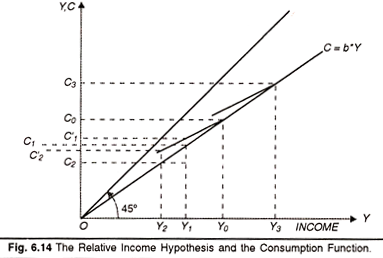The below mentioned article provides quick notes on the relative income hypothesis.
Under the relative income hypothesis, consumption is a function of current income relative to the highest level of income previously attained.
Several versions of the relative income hypothesis exist.
Since that formulated by James S. Duesenberry has received the most attention, we shall concentrate on it. Duesenberry says strong tendencies exist in our society for people to emulate their neighbours and to strive toward a higher standard of living.
ADVERTISEMENTS:
Consequently, if the incomes of individuals increase so as to leave the distribution of income unchanged, consumption increases in proportion to the increase in income. Given these drives and the fact that income increases in the long run, the relevant consumption function is that previously labelled the long-run function. Thus, under the relative income hypothesis, the basic function is the long-run function.
The short-run consumption function is produced by cyclical movements in income. Suppose, in Figure 6.14, income has increased steadily to F0 and consumption has increased to Co. Now suppose income falls to, say, Y1. Instead of consumption falling to C1 people who had a standard of living afforded by income Y0 try to maintain that standard by consuming relatively more of their income.
Consequently, consumption falls, but only to C1 Should income fall still further, say, to Y2, the same phenomenon occurs. Instead of consumption falling to C2 on the long-run function, it falls to C2‘ as people try to maintain their previous standard of living.
Suppose income now starts to increase; consumption increases along the short-run or cyclical consumption function until the long-run consumption function is reached. Once the previous peak income (and consumption) is attained, consumption increases along the long-run function as income increases. Suppose, however, income reaches F3 with consumption level C3.
ADVERTISEMENTS:
If income falls, consumption decreases along the short- run consumption function. Thus, cyclical movements in income produce the short- run consumption function. If there were no business cycles, only the long-run consumption function would be observed.
We have considered two hypotheses, the absolute and relative income hypotheses, which purport to explain consumer behavior. In terms of the analysis of multiplier, the implications of the hypotheses differ. For example, under the absolute income hypothesis, the marginal propensity to consume is constant. Consequently, the values of the multipliers do not vary with the business cycle.
This is not so under the relative income hypothesis. If the economy is in a recession, the marginal propensity to consume is less than when the economy’s income is increasing to new, higher levels of income. As the marginal propensity to consume varies over the business cycle, so will the values of the multipliers. For policy reasons, it is important to know whether the multipliers are constant or variable over the business cycle. Thus, it is desirable to determine which hypothesis better explains consumer behavior.
ADVERTISEMENTS:
Empirical evidence can be cited to support both hypotheses; consequently, it is difficult to accept one hypothesis and to reject the other. Moreover, there is empirical evidence to support other hypotheses, particularly, the permanent income hypothesis.
